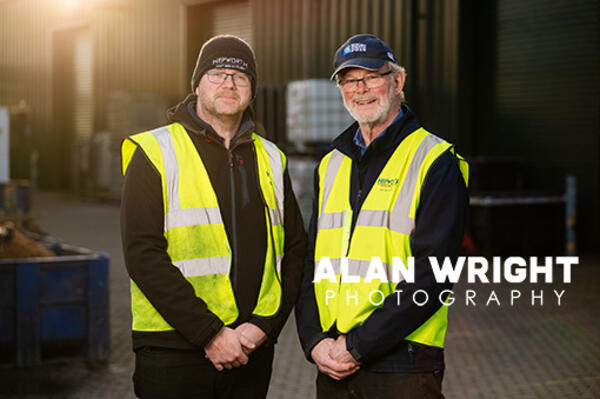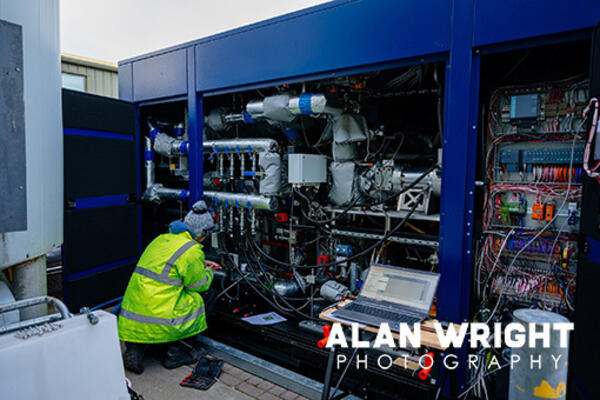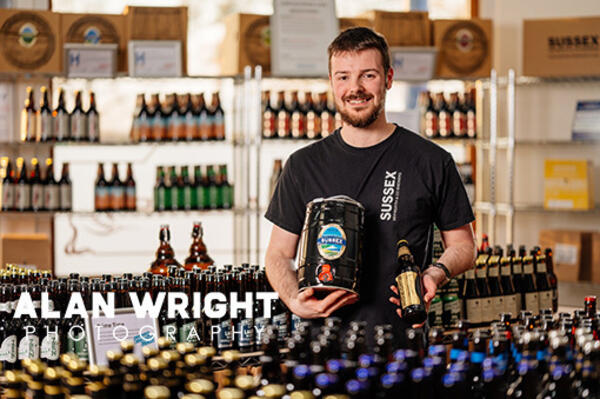SUSTAINABLE BREWING AT HEPWORTH'S

Published on 1st February 2025
Hepworth Brewery celebrates its 25th anniversary later this year. Rather than resting on its laurels, the Pulborough brewery is setting new standards of sustainability in the industry.
Since last October, Hepworth’s have been trialling a pioneering heat pump which will significantly cut its carbon emissions. In what is a UK first, the brewery has installed a Greenstream, a steam-generating heat pump designed by British engineering firm Futraheat. While based on relatively simple scientific principles, putting these principles into practice is complex. However, once fully operational, it could reduce the brewery’s fuel costs by 40% and carbon emissions by 80%.
So, how does it work? As with most brewers, Hepworth heat water to generate steam to the high temperatures required to brew beer. Waste heat then rises to the top of the brewing kettles and – in days gone – would typically be released into the atmosphere via a chimney. What Futraheat’s pump does is collect this low-grade waste vapour as it rises and delivers it back to the heat pump.
At the heart of the Greenstream is a patented TurboClaw compressor, which takes the waste vapour and converts it into re-usable steam. This is heated to 130oC (far higher than what a regular heat pump can achieve) and fed back into the bottom of the brewing kettle. Although tests are still being carried out, the heat pump could eventually power all of the brewing processes at Hepworth, reducing its carbon footprint significantly.
Andy Hepworth, Founder and Chairman, said: ‘Futraheat’s engineers have been working with us for several months, testing various processes and scenarios. This is the first Greenstream heat pump in the UK, so we’ve had to control and monitor the processes of this prototype to make sure all our parameters are correct. In January, we were able to collect steam directly from the boiler and prove the increase in temperature, so we’ll soon reach a point where we can use it to brew beer.’
‘We have always championed sustainable practices and were one of the first breweries to develop its own heat pump. I studied microbiology at university and – literally over a couple of pints – helped plan our first heat pump. It wasn’t the most sophisticated device, but it worked phenomenally well. As well as improving our green credentials, it proved financially beneficial, particularly during a period of rising energy costs.
However, we knew we could be even more efficient and that led to our partnership with Futraheat, which takes us to another level. It takes between 1000kW and 1500kW of power to boil the kettles, so if we’re brewing once or twice a day, the recyclable process will make a huge difference to our carbon footprint. While investment in green technology is great, there has to be financial benefits. It might be that the payback for us comes a long way down the road, but our vision is a long-term one.’

BREWING HERITAGE
This year, Hepworth Brewery celebrates a quarter of a century in business. Andy’s first job in the industry was as a brewer at the old H&G Simonds Brewery in Reading, which had then amalgamated with Courage & Barclay. He worked there for four years and some of the brewing tanks now at Hepworth’s were once used by Courage, dating back to the late 1950s yet as efficient as ever. Andy then joined King & Barnes in Horsham, becoming its head brewer at the age of 30. He remained with the company until 1999, shortly before it was bought by Hall and Woodhouse and the brewery closed.
Having always said that he wouldn’t set up his own brewery, Andy did precisely that and Hepworth’s was born. Tim Goacher, who worked as an apprentice at King & Barnes, joined him from the outset and the two still work together, with Tim now Production Director. Their first beer was a bitter, Pullman, which remains one of the brewery’s best-sellers. After 15 years behind Horsham Rail Station, the brewery moved to a new location at Stane Street in Pulborough, where is has continued to adapt to an ever-shifting market place.
Hepworth continues to offer a range of heritage beers, including Prospect (pale ale), Pullman (best bitter) and Iron Horse (pale ale). Other successful beers include Conqueror (stout), Right Stuff (APA), Charger (IPA), Crazy Horse(APA), Saxon (lager) and Blonde, a crisp lager brewed with organic hops. Hepworth has also made strides into the craft beer market and hopes to find more success with new products to be launched during its 25th year.
Matthew Woodward, Marketing Manager, said: ‘We invested in a canning line in 2022 and introduced our Sussex craft beers. The Sussex range includes six beers (lager, pale ale, APA, stout and two low-alcohol lagers) in 330ml cans. Customers loved the taste, but we lost the characteristics of the individual beers by branding them all as Sussex. So, we will are repackaging our craft beers and launching them in the coming months. This coincides with the introduction of a new logo and strapline of ‘great beer, naturally’ to encapsulate our ethos of brewing great-tasting beer from natural, high-quality ingredients, while striving to become a more sustainable brewer.’
‘Low alcohol beers are in demand and that is another area of focus. We brew two 0.5% beers – Spartan and Aztec, a lager blended with the syrup and inulin of the Agave cactus. We’ve created another 0.5% lager, UNLTD, to appeal to a different market. To celebrate our anniversary, we hope to host a festival with its own beer, perhaps based on an early Hepworth recipe, and offer more seasonal beers in future too. We already have Christmas Cracker and have mooted Oktoberfest and a summer beer, so watch this space.’
‘Every leading brand uses a segmentation model that identifies its target market. A big slice of our market is mature traditionalists, who enjoy drinking our Heritage ales. We also appeal to eco-conscious craft drinkers and health-conscious drinkers seeking high-quality, low alcohol beers. Another market is young, urban drinkers and we don’t have the products to cater for them, so that’s something we will be focusing on in the near future.’

CONTRACT BREWING
As well as supplying beer to pubs and bars, Hepworth sells its own bottles and cans (as well as mini kegs and polypins) at its Brewery Shop, which also stocks products from other local producers, including Silly Moo cider and gin by Cabin Pressure Spirits. However, sales of its own beers only account for about a third of production at Hepworth’s, with the rest of its business generated through contract brewing.
It has developed beers for Marks & Spencer and brews a Nepalese lager sold under the Gurkha brand. They also work with Ridgeway Brewery and Prime Time, founded by two friends from TV show Made in Chelsea. The site also encompasses the Goodwood Brewery, where beers are brewed using malted barley grown on the Goodwood estate. Beers such as St. Simon and Lucky Leap are hugely popular at events such as Glorious Goodwood and the Festival of Speed.
Andy said: ‘It can be beneficial for companies to work with a contract brewing partner, without investing in their own production facilities. They come to us as we have vast experience of brewing, as well as packaging equipment and strong sustainability credentials. We always have discussions with partners about their product, as the language of taste is not set. People perceive flavours and aromas differently, so our partners lead the development of their own beers. While they might be brewed and labelled here, partner companies design their own branding and can often be better at marketing their products than we are.’
SACROSANCT BREWING
The Greenstream heat pump is the latest in a long line of sustainability measures undertaken at Hepworth’s, including the installation of solar panels, as it aims to become 85% carbon neutral by the end of 2025. Soon, the brewery will be installing an anaerobic digester, which converts the organic matter in waste water into biomethane, a renewable energy source. A typical brewery will use six or seven pints of water for every pint of beer. Through its current initiatives, Hepworth currently uses four-and-a-half pints and hopes to reduce that figure to three pints when the anaerobic digester is operational.
Andy now takes more of a back seat in the business, overseeing special projects while Tim heads up the brewery and Managing Director Leo Murphy drives forward sales and the contract brewing partnerships. The future success of Hepworth Brewery may now be in the hands of others, but Andy is confident that the business he founded will remain true to its roots.
He said: ‘Consistency is key to the art of brewing. To be consistent, you’ve got to manage the natural ingredients perfectly every time you brew. This could be done by automation if the hops and yeast were always exactly the same, or there were never any alterations in barley crops. However, there are always subtle changes and that is why brewing is best done by eye, by experienced brewers who have a feel for the machinery, the processes and the natural ingredients. When it comes to cleaning and running machines, automation is fine. But there is craftsmanship behind brewing and the level of creativity required to do it well can only be achieved by a human.’
‘Even as we strive to achieve carbon neutrality, the traditional brewing methods we use are sacrosanct. The way we produce beer – working with local suppliers, brewing without additives and preservatives – is absolutely key to our success. However, the cleaning processes we use and how we generate electricity – be it solar panels or any other source – are not of vital importance to the brewing process and by being smarter, we can become a more efficient, sustainable business.’
WORDS: Ben Morris / PHOTOS: Alan Wright
Further information:
Visit the brewery and Tap Room at Stane Street, Pulborough, RH20 1DJ or visit www.hepworthbrewery.co.uk


